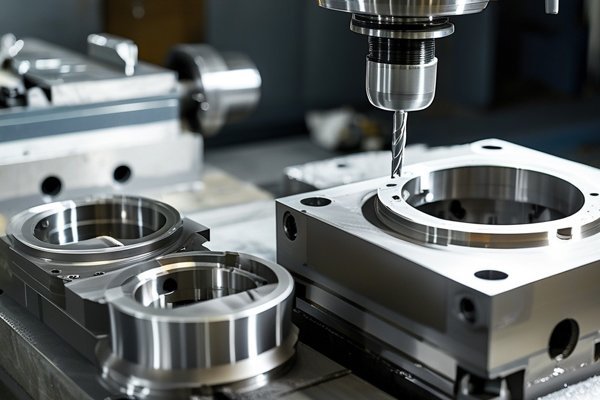Introduction: The Fabrication Renaissance
Picture this: you’re standing in a bustling manufacturing facility, surrounded by the whirs and whizzes of state-of-the-art machinery, each functioning in perfect harmony to create precision parts. This is not just a day in the life of a factory worker; it’s a glimpse into the future of manufacturing, where innovation meets efficiency. At the heart of this revolution lies the wonder of CNC machining — a technology that has transformed the way we think about producing steel components.
So what exactly is CNC machining, and why should you care? Well, why not think of it like a skilled chef in a kitchen? Just as a chef uses precise measurements and techniques to cook up a delicious dish, CNC machining employs intricate programming and high-tech machines to shape steel into perfectly crafted parts. But hold on; this isn’t just a matter of cool tech and shiny machines. The impact of CNC machining on manufacturing processes, especially when it comes to steel, is astonishing. This article will delve deep into how CNC machining steel improves precision, boosts efficiency, and is driving the future of production.
What Is CNC Machining?
Before we dive deeper, let’s clarify what CNC machining is, in case you’re just tuning in. CNC stands for Computer Numerical Control. It’s like having a personal assistant (that’s exceptionally good at math) directing machines on how to operate. Using software to create a CAD (Computer-Aided Design) model, CNC machines can interpret commands via coded instructions. Think of it as a robot shaping steel based on a meticulously crafted blueprint.
In essence, CNC machining allows for the mass production of highly complex shapes and components with unprecedented accuracy. This technology can handle a wide range of materials, but today we’re honing in on steel, a stalwart in the manufacturing world.
The Importance of Steel in Manufacturing
Now, why steel? Well, steel is called the backbone of industrial production for very good reasons. Strong, resilient, and versatile, steel is the material of choice for an array of applications, from automotive parts to heavy machinery. Imagine steel as the sturdy foundation of a skyscraper; without it, the whole structure would crumble. This is why understanding the machining of steel, particularly CNC machining, is crucial for anyone involved in manufacturing.
The Precision Factor
One of the key attractions of CNC machining steel is its accuracy. CNC machines can produce components with tolerances as tight as ±0.001 inches (that’s about the thickness of a human hair). But how do they achieve such incredible precision? Let’s break it down.
In traditional machining, the human factor often leads to variations. Picture a skilled machinist manually measuring and cutting steel. Even the most experienced handiwork can fall into a realm of inconsistency. CNC machines, on the other hand, follow pre-programmed paths, effectively eliminating measurement errors. Each piece is manufactured according to the same digital blueprint, leading to uniformity across the board.
CNC machines work with a variety of cutting tools, ensuring that you have the right tool for the job every time. Think of it like a Swiss Army knife, with the right blade for whatever task you’re tackling. These tools can be changed quickly based on the machining requirements, allowing for smoother transitions and maintaining quality.
Automation is the name of the game. Machines can run continuously, day and night, for extended periods without supervision. They can be programmed to perform complex operations like drilling, milling, and turning with laser-like precision. Wouldn’t you agree that having a dedicated workhorse that never tires sounds like a dream come true?
Efficiency at Its Best
Moving beyond precision, there’s another pillar of CNC machining that’s worth discussing: efficiency. In a world where time is money, efficiency can make or break a manufacturing operation. Let’s see how CNC machining steel turns the dial on efficiency.
Time is of the essence, and CNC machining delivers speedier cycle times than manual machining processes. While a traditional machinist might take hours perfecting a part, CNC machines can often complete the task in a fraction of that time. This means faster turnaround and significant boosts to production schedules.
CNC machining is masterful when it comes to optimizing material usage. In traditional methods, cutting larger pieces often leads to wasted materials. CNC machines, with their precise cuts, help to minimize scrap. Picture crafting a work of art; every cut matters, and CNC provides a meticulous cutting approach, ensuring that less material goes to waste.
Why wait weeks for a part when CNC machining can create it in days? With streamlined operations and efficient workflows, manufacturers can cut down on lead times drastically. Imagine walking into a store looking for something you’ve been eyeing for months, only to find it available – that’s the satisfaction customers feel when they receive their parts sooner than expected.
Modern CNC machines can be integrated with other technologies, like robotics and automation systems, creating seamless workflows across manufacturing processes. Think of it like assembling a championship-winning sports team, each player knowing their role and performing at their best.
A Custom Touch: CNC Machining Steel
What about customization? One of the greatest perks of CNC machining is its ability to accommodate custom designs. Want a unique part that fits a specific need? You got it! Let’s explore how CNC machining offers this bespoke advantage.
CNC technology allows engineers to explore complex designs that may have been a pipe dream a few decades ago. Whether it’s curves, intricate geometries, or tight tolerances, CNC machines can bring those designs to life.

Need to see a concept in physical form? CNC machining is your ticket to rapid prototyping. Designers can create proofs of concept in record time, allowing for faster feedback loops. It’s like cooking a new recipe for dinner and tweaking it as you go; quickly see what works before committing to the final dish!
While we’re focusing on steel, CNC technology is compatible with various materials. This means you can design parts that incorporate multiple materials to achieve desired characteristics, much like adding ingredients to a favorite meal to enhance the final flavor profile.
Quality Control and Assurance
CNC machining doesn’t just create parts; it guarantees quality. Automated inspections and testing are embedded into the process, ensuring that every piece meets rigorous standards. Here’s how quality control shines through.
CNC machines often incorporate real-time monitoring systems that analyze production processes on-the-fly. Think of it as a coach keeping an eye on their players during a game, ready to make adjustments as needed to ensure victory.
Standard operating procedures (SOPs) dictate regular inspections and checks, further ensuring that each piece produced meets the necessary specifications. It’s like quality assurance officers looking over every blade of grass in a neatly manicured lawn, confirming everything is in order.
With automated processes in play, the chance for human error diminishes significantly. CNC machines operate independently, adhering to programmed instructions without fatigue or distraction. It’s like having a diligent worker who’s always focused and never takes a coffee break.
Challenges and Limitations of CNC Machining
While CNC machining offers fantastic benefits, it’s also essential to acknowledge its challenges and limitations. This technology isn’t without its hurdles, and understanding these can help us navigate the terrain more effectively.
One of the primary hurdles in adopting CNC technology is the initial investment. CNC machines can be expensive, particularly for advanced models. However, consider it a long-term investment; the returns in efficiency and precision over time often far outweigh the initial expenses.
While CNC machines are incredible, they do require skilled operators. This means investing in training and hiring qualified personnel. Think of it as learning to ride a bike; it takes some practice and know-how before you can tackle the big hills.
While CNC machining accommodates various materials, not every steel type or grade is suitable. Understanding the material’s characteristics is essential to avoid pitfalls that could lead to compromised quality.
The Future of CNC Machining Steel
So, what does the future hold for CNC machining, particularly when it comes to steel? The landscape is continually evolving, driven by technological advancements and the need for greater efficiency. Here are some emerging trends that are shaping the future.
The rise of artificial intelligence (AI) and the Internet of Things (IoT) is making waves in manufacturing. Imagine CNC machines that can predict failures or optimize their own performance. This capability is becoming increasingly feasible, leading to smarter factories and operations.
As the world becomes more environmentally conscious, the push for sustainable manufacturing practices intensifies. CNC machining offers better resource utilization and reduced waste, which aligns perfectly with sustainability goals.
The collaboration between CNC machining and 3D printing, or additive manufacturing, is on the rise. By merging these two technologies, manufacturers can create complex geometries with precision while benefiting from both subtraction (CNC) and addition (3D printing) processes.
Conclusion: The Industrial Symphony of CNC Machining Steel
In the grand narrative of modern manufacturing, CNC machining steel plays a crucial role in shaping the future. It’s a synergy of precision, efficiency, customization, and quality assurance, wrapped up in a comprehensive process that transforms raw materials into finely-tuned components.
So, whether you’re an engineer, a manufacturer, or simply someone fascinated by what goes on behind the scenes of our industrial world, understanding CNC machining steel is essential. Like a well-composed symphony, every element must work harmoniously together, ensuring that the final piece is not just functional but also a marvel of craftsmanship.
As we look ahead, it’s evident that CNC machining will continue to propel innovation, crafting the steel components that will carry us further into the future. Who knows? The next big breakthrough in manufacturing might just be a CNC machine away!






